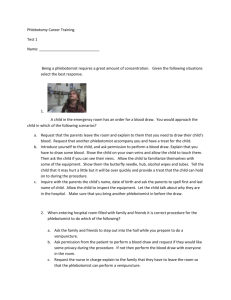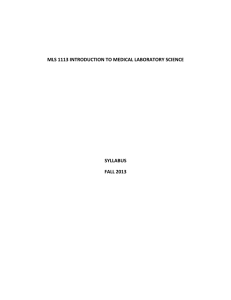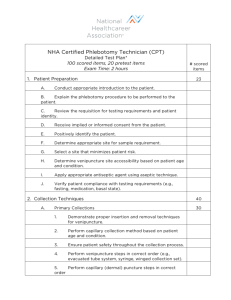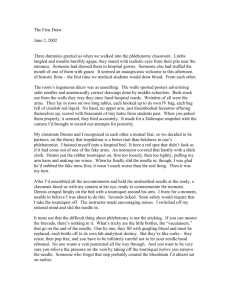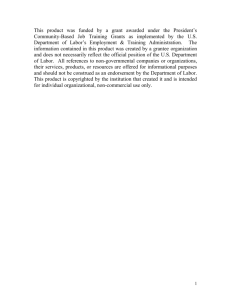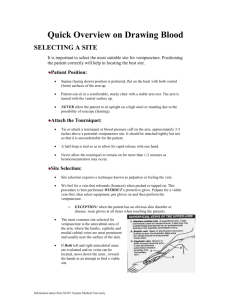1 Fundamentals of Phlebotomy
advertisement
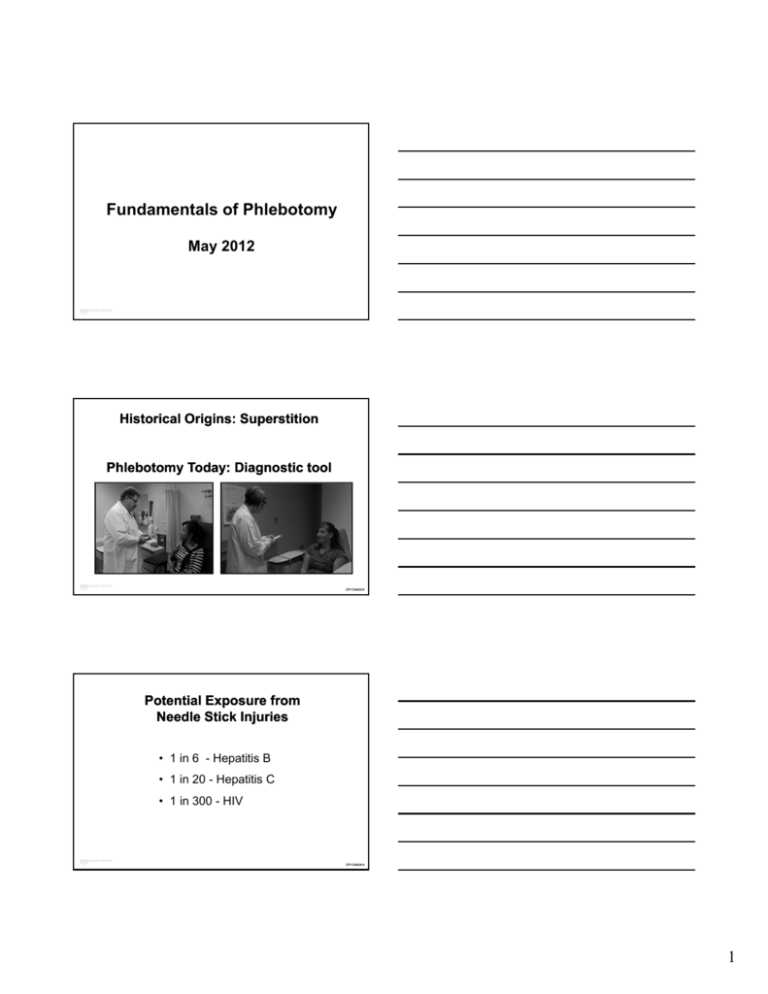
Fundamentals of Phlebotomy May 2012 Historical Origins: Superstition Phlebotomy Today: Diagnostic tool CP1154634-9 Potential Exposure from Needle Stick Injuries • 1 in 6 - Hepatitis B • 1 in 20 - Hepatitis C • 1 in 300 - HIV CP1154634-9 1 Tracking at Mayo Clinic Rochester 1983-1996 Decline from 1.5 Exposures/10,000 to 0.2 Exposures/10,000 1985 1-handed recapping blocks 1987 Disposal of evacuated holders 1988 CDC Universal Precautions 1989 CDC HIV and Hepatitis B prevention guidelines 1991 OSHA occupational exposure to bloodborne pathogens final rule CP1154634-27 Tracking at Mayo Clinic Rochester (cont) 1983-1996 Decline from 1.5 Exposures/10,000 to 0.2 Exposures/10,000 1992 Resheathing needles and retractable lancets 1992 Biohazard container improvement initiative 1994 “Clean” needle stick removed from database 1995 Discontinued changing needles for blood cultures CP1154634-28 Tracking at Mayo Clinic Rochester 1983-1996 1983 1984 1985 1986 1987 1988 1989 1990 1991 1992 1993 1994 1995 1996 Frequency Rate per 10,000 punctures CP1154634-29 2 2010 Blood/Body-Fluid Exposures • 592 Needlestick and Blood/Body-Fluid Exposures occurred to Mayo staff during 2010 (161 “hollow core punctures” – or needles) Order Entry, Phlebotomy Supplies and Safety New Device / Equipment Evaluation Device / Equipment Name_________________ Evaluation Site_______________Date of Evaluation_____________ Rating Scale Strongly Agree (please circle)- Strongly Disagree Is the Device Safe? 5 4 3 2 1 User Friendly? 5 4 3 2 1 Easily Adapted to the Work Environment? 5 4 3 2 1 Better than existing device? 5 4 3 2 1 Comments 3 Research from Center for Disease Control (CDC) “Research from CDC … indicates that selecting safer medical devices could prevent 62-88% of sharps injuries in the hospital setting…” Szabo J: MLO 33(3):18, 2001 CP1154634-17 Orders for Collection & Preparing the Accession Order • Ordering the collection •Physician •Designated healthcare professional • Preparing the order for collection •The phlebotomist Phlebotomy Safety: Hand Cleansing • Soap & Water • Waterless Hand Sanitizer CP1154634-12 4 Safety: Latex Allergy • Studies indicate that 5-17% of healthcare workers show latex sensitivity, compared to 1-6% of the general population • Exposure can be reduced by switching to lower allergen products, or by using non-latex substitutes CP1154634-41 Phlebotomy Supplies: Needles 5 Phlebotomy Supplies: Evacuated / Syringe / Winged Infusion Phlebotomy Supplies: Skin Preparations • 70% Isopropyl Alcohol • Tincture of Iodine Phlebotomy Supplies: Gauze and Pad & Gauze Roll 6 Phlebotomy Supplies: Capillary Collection Devices Capillary Collection Phlebotomy Supplies: Needle Gauge* * Determined by the size & condition of the vein 7 Considerations Prior to the Collection • Thorough patient history • Patient condition • Time of collection • Basal state • Fasting • Age • Gender • Diurnal or daily variations Additional Considerations • • • • Age Growth Development Safety Considerations • Communication Physical Conditions of a Patient Affecting Blood Collections • Stress • Dehydration • Strenuous exercise • Pregnancy • Smoking habits • Weight, age and other factors 8 Mayo Clinic Patient Identifiers • Patient must state and spell their first and last name • Patient must state their date of birth Patient Identification 2 1 4 3 3 3 Additional Variables to Patient Identification • Language or cultural barriers • Pediatric patients • Unidentified patients • Unconscious patients • Dementia, Intubated patients and other possibilities 9 NOTE: • It is the responsibility of the phlebotomist to perform PATIENT IDENTIFICATION with each and every patient interaction regardless of how many times in a work shift the phlebotomist may see the same patient for additional collections. Patient Identification, Arm Anatomy, & Collection Materials Approach & Identify the Patient • • • • Identifying yourself Observe surroundings Considerations Patient to spell first & last name • Patient to give date of birth • Tech code or initial all collection labels 10 Vein Assessment • Site selection process and anatomical structure. Arm Anatomy: Preferred Sites/Veins Cephalic Vein Median Cubital Vein Basilic Vein Three Phlebotomy Methods • Evacuated • Syringe • Winged Infusion (Butterfly) 11 Joint Commission Recommended Guideline for Age Groups • • • • • • • Infant and toddlers: 0 to 3 years Young children: 4 to 6 years Older children: 7 to 12 years Adolescence: 13 to 20 years Young adults: 21 to 39 years Middle adults: 40 to 64 years Adults: 65+ years Site Selection Process: Considerations • Burn and/or Scars • Skin Integrity • Edema • Hematoma • Mastectomy The Venipuncture Procedure 12 Evacuated Tubes • Color Codes • Anticoagulated Tubes • Citrate – light blue • Heparin - green • EDTA – Purple, pink, or lavender • Oxalate/Fluoride (antiglycolytic) - gray • Serum tubes • Gel Separator - gold or red/black • Non- gel separator - red CLSI (NCCLS) H3-A5 Order of Draw • Culture tubes (not illustrated) • Coagulation tubes • Serum tubes • with or without clot activator • with or without gel • Heparin tubes • with or without gel • EDTA tubes • Oxalate/fluoride tubes Mayo Clinic Order of Draw • Serum Gel Separator • Serum (Red) • Anticoagulant Tubes • Citrate • Heparin • EDTA • Oxalate/Fluoride 13 Evacuated Tube Considerations • Mixing* by gentle inversion • Fill volumes of the of tubes * Follow manufacture's guidelines for the number of inversions Patient and Sample Identification • The consequences of an incorrectly labeled tube are the same as an incorrectly identified patient. Tips for Phlebotomists • Remain calm, professional and polite • Place no blame • Look at all possible sites for second collection • Apply heat • Consider reduced amounts • Consult a more experienced phlebotomist 14 Specimen Transport Specimen Processing Hematoma forming 15 Conditions That Cause a Hematoma • Needle placement • Failure to remove the tourniquet before removing the needle • Not applying adequate pressure on the site after the needle is removed Needle Placement Conditions That Cause a Hematoma • Accessing the vein too slowly • Needle is too deep and has gone completely through the vein Ways to Prevent a Hematoma • Penetrate only the upper most vein wall • Remove the tourniquet before removing the needle • Use major veins, not superficial veins • Apply gentle pressure to the site with gauze after needle removal and while bandaging 16 1 2 3 4 1- Hemolyzed 2-“Normal” 3- Icteric 4- Lipemic Acute Hemolysis Elliott K, et al. Transfusion 43:297, 2003 Common Complications of Phlebotomy • Fainting • Nausea WHAT TO DO? • • • • Safety of the patient is the first concern Immediately stop procedure Do not leave patient unattended Call for assistance if needed 17 The Venipuncture Process: Evacuated Method • • • • • • • • Patient Identification Tourniquet application Site selection & cleansing Phlebotomy collection Removal of the tourniquet Remove needle and apply pressure Wrap and secure site Label tubes The Venipuncture Process: Winged Infusion with a Syringe • • • • • • • • • Patient Identification Tourniquet application Site selection & cleansing Phlebotomy collection Removal of the tourniquet Remove needle and apply pressure Wrap and secure site Dispense blood Label tubes The Venipuncture Process: Syringe Method • • • • • • Patient Identification Tourniquet application Site selection & cleansing Phlebotomy collection Removal of the tourniquet Remove needle and apply pressure • Wrap and secure site • Dispense blood • Label tubes 18 The Venipuncture Process: Winged Infusion /Evacuated Method • • • • • • Patient Identification Tourniquet application Site selection & cleansing Phlebotomy collection Removal of the tourniquet Remove needle and apply pressure • Wrap and secure site • Label tubes References Accuracy in Patient and Sample Identification. GP33-P. (2009). CLSI. 29(13) Dale, J. C., Hermansen, J., McConnell, Nielsen, J. (1998). Accidental needlesticks in the phlebotomy service of the department of laboratory medicine and pathology at Mayo Clinic Rochester. COMMUNIQUÉ – A Mayo Medical Laboratories Publication. 23(5). Dale, J. C., Pruett, S. K., and Maker, M. D. (1998). Accidental needlesticks in the phlebotomy service of the department of laboratory medicine and pathology at Mayo clinic Rochester. Mayo Clinic Proceedings. 73(7). 611-613. Procedures and Devices for the Collection of Diagnostic Blood Specimens by Skin Puncture, 5th ed. H4A6. (2004). NCCLS. 24(21). Procedures and Devices for the Collection of Diagnostic Capillary Blood Specimens, 6th ed. H4-A6. (2008). CLSI. 28(25). Procedure for the Collection of Diagnostic Blood Specimens by Venipuncture, 4th ed. (1991). H3-A3. NCCLS. 11(10). Procedure for the Collection of Diagnostic Blood Specimens by Venipuncture, 5th ed. (2003). H3-A5. CSLI. 23(32). Procedures for the Collection of Diagnostic Blood Specimens by Venipuncture, 6th Ed. (2007). H3-A6. CLSI. 27(26) Szabo, J. (2001). MLO. New OSHA bloodborne pathogen standard clarifies need for employers to select safer needle devices. 33(3). 18. 19
